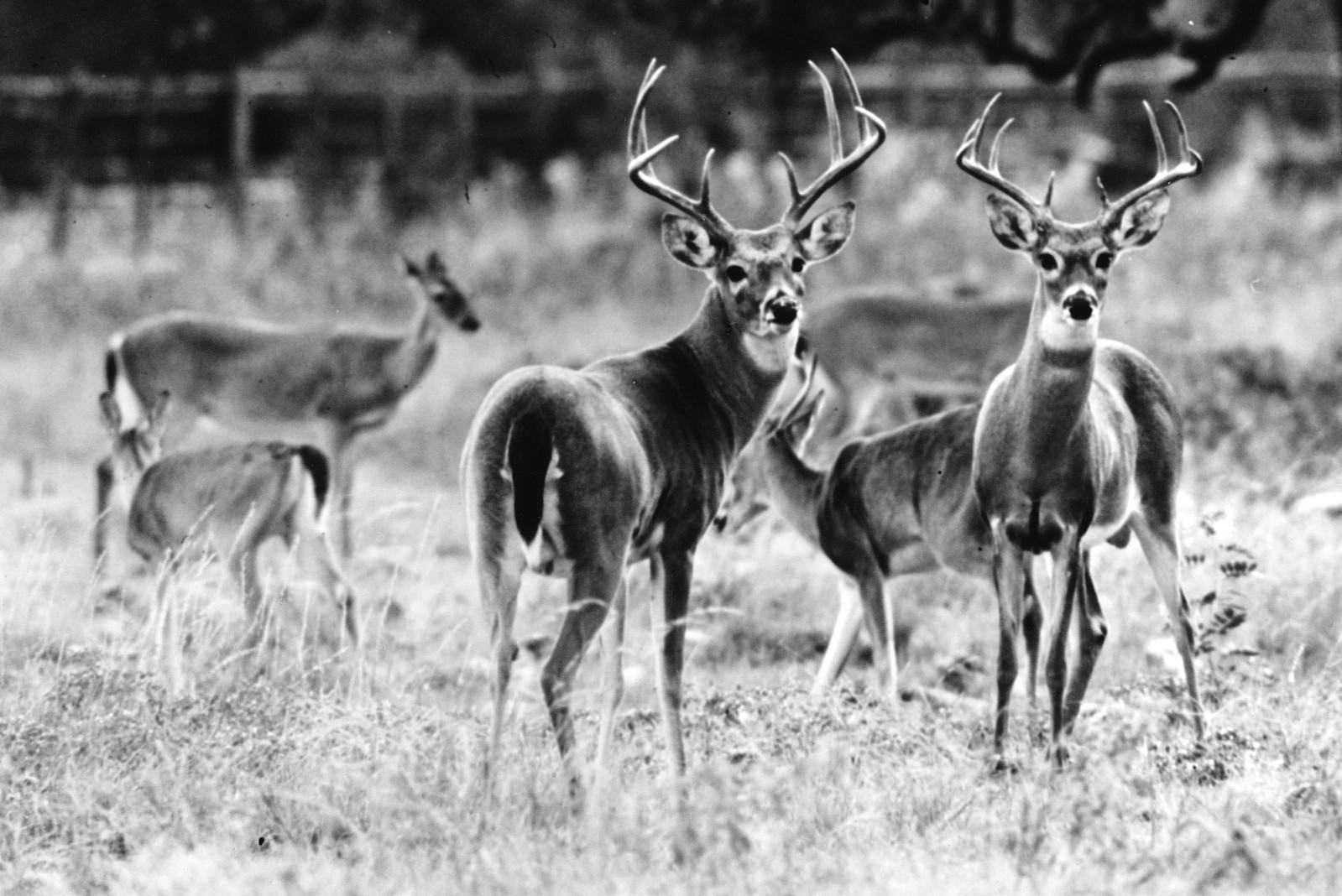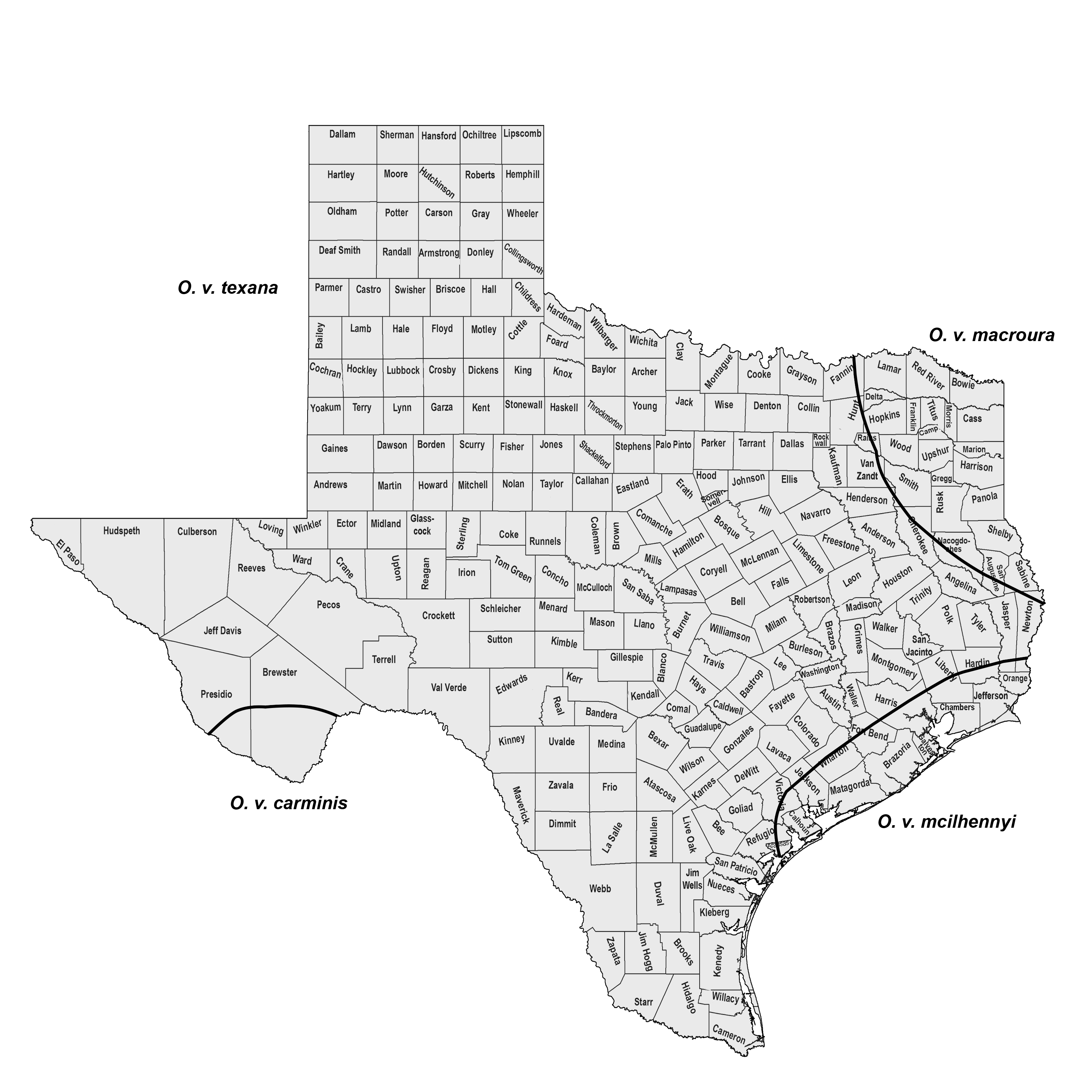WHITE-TAILED DEER
Odocoileus virginianus (Zimmerman 1780)
Order Artiodactyla : Family Cervidae
DESCRIPTION. A relatively small deer with relatively short ears; all major points of the antlers come off the main beam; tail relatively long, broad basally, and white underneath; metatarsal gland small and circular; females usually antlerless; upperparts reddish brown in summer, bright grayish fawn sprinkled with black in winter; face and tail usually lack blackish markings; underparts white. Dental formula: I 0/3, C 0/1, Pm 3/3, M 3/3 × 2 = 32. Averages for external measurements: of males, total length, 1,800 mm; tail, 300 mm; hind foot, 450 mm; females slightly smaller. Weight of males, 30–70 kg; females, less.

DISTRIBUTION. Suitable brushy or wooded country throughout the state.

SUBSPECIES. Originally included O. v. carminis, known only from the Big Bend area, O. v. macroura in the extreme northeastern corner of the state, O. v. mcilhennyi along the Gulf Coast, and O. v. texana throughout the central part of the state. Native animals of the subspecies O. v. mcilhennyi and O. v. macroura were eliminated in eastern Texas, and the area was restocked with individuals of O. v. texana.
HABITS. White-tailed deer occur almost entirely in the hardwood areas within their general range, except for the southeastern section of Texas where the principal vegetation is a mixture of pines and hardwoods or nearly pure stands of pines. In the Chisos Mountains they occur in the mountains, whereas the mule deer occupy the lower foothills and broken deserts; in most other places this habitat relationship is reversed. For example, in the Guadalupe Mountains the whitetail occurs almost entirely in the foothills, the mule deer in the higher mountains.
White-tailed deer have a relatively small home range and cruising radius. Normally, when food conditions are adequate, the deer tend to stay in one locality for long periods. For example, in the Edwards Plateau region, where deer were belled (marked) in an experimental study, many of the marked deer remained on an area of 259 ha (640 acres) for at least 3 years. A few of them were found as far away as 8 km (5 mi.).
Deer are most active just before sunset and again shortly after sunrise. It has been found in experimental trials that they are most easily observed in the hour just before dark. During the middle part of the day they are generally bedded down in some thicket or on some promontory where they are more or less protected. Under cover of darkness it is not uncommon for them to feed well into the night, but there is usually a period of resting and cud chewing during the middle part of the night. In regions heavily populated with deer, trails and beds are readily seen and give some indication as to the density of the population. Beds usually are scraped out under the protection of overhanging boughs or at the bases of trees.
As with most other mammals, the feeding habits of whitetails vary from place to place and from season to season. In 1939, Earl L. Atwood (University of Wisconsin) listed over 500 different plants utilized by whitetails in the United States. Availability determines in large measure what the animals will eat, but if adequate food is available, the deer are dainty eaters and exercise considerable choice in the items taken. In the Chisos Mountains of Trans-Pecos Texas, whitetails feed extensively on mountain mahogany and other low shrubs. In the Edwards Plateau region the deer graze on forbs twice as much as they browse. There, 67% of their total feeding time was spent in grazing on forbs and grasses, 26% in eating fruits and mast, and only 7% in browsing. In southern Texas, however, browse species make up the bulk of the diet.
The 10 most favored foods as observed in the Edwards Plateau of Texas are grasses and forbs, Mexican persimmon, live oak acorns, live oak leaves, mesquite beans, oats or other grain, Spanish oak acorns, spike rush, Foresteria or elbow bush, and turkey pear. On the basis of food consumed, seven deer will eat about as much as one medium-sized cow.
White-tailed deer are polygamous. The rut begins in early fall and continues through early winter. The onset of breeding varies considerably from one section of the country to another. In coastal Texas, for example, breeding sometimes begins as early as September. In the Edwards Plateau, not more than 300 km (186 mi.) distant, the peak of the breeding season is in November, whereas in the southern brush country of Texas the peak is in late November and December.
The fawns, usually one or two in number, are birthed after a gestation period of approximately 7 months and hidden by the female for 10 days to 2 weeks. She goes several times daily to nurse them, but soon they are strong enough to follow her during her daily routine. The spots are retained until the fawns molt in early fall, by which time they are usually weaned. Normally, females do not reach sexual maturity until the second year, but occasionally, when food conditions are excellent, female fawns mate the first fall and produce offspring the following spring, when they themselves are only 1 year old. That appears to be unusual throughout most of their range.
There is a relationship between testicular activity and the growth and shedding of antlers. The antlers begin their annual growth when the testes and accessory organs are inactive, harden and lose their velvet when the glands are enlarging, and are shed when the glands begin to shrink. Castration following loss of the velvet results in shedding within 30 days; new growth, which occurs at the normal time, is abnormal in shape, and the velvet is not lost; and growth ceases at the usual time, and part of the growth, being somewhat fragile, may be lost by accident. Renewed growth activity follows in the spring. Eventually, an aggravated burr is produced. These events have been interpreted as indicating that antler growth is under the influence of a nontesticular hormone, possibly from the anterior pituitary, and antler hardening and subsequent loss of the antler is due to the action of a testicular hormone.
One can estimate the age of whitetails by examination of the teeth. At 9 months of age, the fawn will be acquiring the middle pair of permanent incisors while the remainder of the incisors as well as the premolars will be milk teeth. At this age one molar on either side of each jaw is well developed while the second is barely breaking through the gum. At the age of 1.5 years, all milk incisors have been replaced by permanent teeth. At least two molars are fully developed while the third may be in any condition, from barely emerging from the mandible to fully emerged. At the age of 2 years, the full set of permanent teeth is acquired. Beyond 2 years, age determination is somewhat uncertain but can be roughly estimated by the wear evident on the teeth. Wear of the teeth is gradual until, at 5 years, the ridges of enamel are no longer sharp but rise slightly and gradually above the dentine. At still later ages the crowns of the premolars and molars rise only a short distance above the gums, and the grinding surfaces are worn practically smooth. Although this technique is reliable, variation is injected in sandy soil regions, where the teeth can wear at a more rapid rate.
Contrary to popular opinion, it is almost impossible to determine the age of deer accurately from the number of points on the antlers. For example, the shed antlers collected from one buck in Texas over a period of 5 years had each year either four or five points on each side. There is some correlation between age and diameter of the beam of the antler, however. The older bucks tend to have heavier antlers, but antler development also is so closely associated with nutrition and genetics that it is difficult to make generalizations concerning age and diameter of the beam. Also, a certain amount of geographic variation is seen in antler development.
On some ranges there is considerable competition for forage between white-tailed deer and domestic livestock. This is particularly true between deer and domestic goats. Competition between deer and cattle is not so severe. Where abundant in farming areas, deer often become pests and destroy such crops as peas, peanuts, wheat, oats, and other small grains.
POPULATION STATUS. Common. This is the most economically important big game animal in Texas. It is estimated that the 2014 white-tailed deer population numbered 3,959,600 and that the statewide harvest by hunters for 2013 was 625,577. The population seems to be stable, healthy, and steadily increasing in most regions of the state. Improved habitat management efforts and protection by private landowners offer a serious opportunity to increase deer numbers. The problem in Texas is that we do not harvest enough deer across the state; consequently, deer numbers are expanding and beginning to affect native animals and plants. It has been estimated that deer cause more than one million automobile wrecks amounting to around $1 billion in damage per year.
CONSERVATION STATUS. The IUCN lists the white-tailed deer's status as least concern, and it does not appear on any federal or state lists of concerned species. This species is in good shape.
From The Mammals of Texas, Seventh Edition by David J. Schmidly and Robert D. Bradley, copyright © 1994, 2004, 2016. Courtesy of the University of Texas Press.
Natural Science Research Laboratory
-
Address
Museum of Texas Tech University, 3301 4th street, Lubbock, TX 79409 -
Phone
806.742.2486 -
Email
nsrl.museum@ttu.edu

